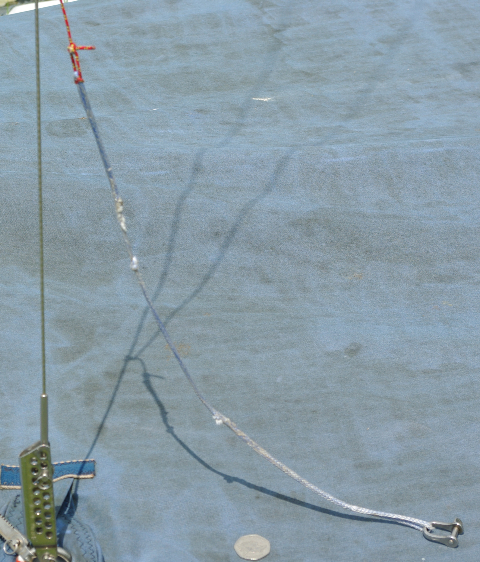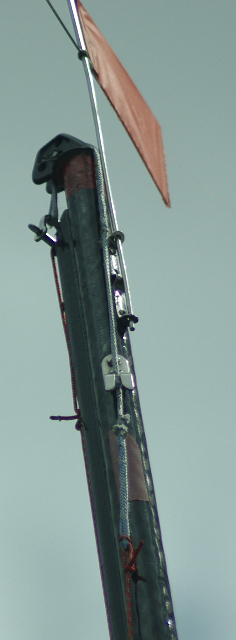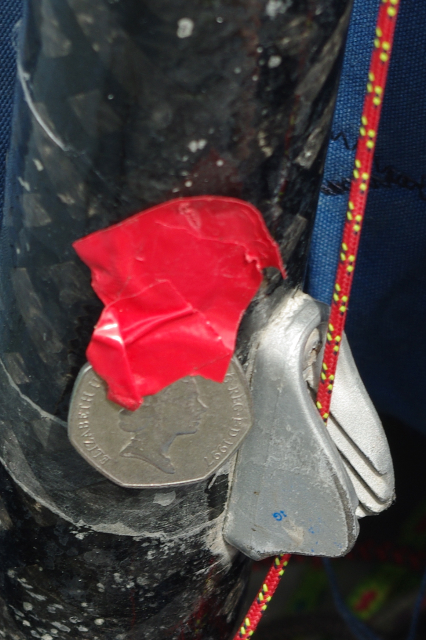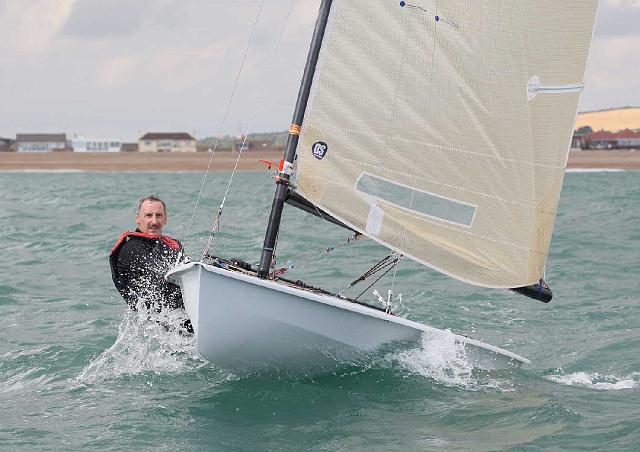This is an alternative external halyard setup sent in by Ben Falat. It uses a system that is common on boats such as the D1, Finn and Europe. On certain Superspar masts there is a cleat 8 inches or so down from the top of the mast but they can be prone to slippage as the cleat or rope wear. With Ben's system there is no slippage at all.
The haul-up part is is only 2mm line (red in photos) which runs through the masthead block, bears against the for'd aluminium of the masthead casting and then down the front/side of the mast into a small cleat at the base just to give it some tension; to fully tidy it away it is slid into the mainsail track at the gooseneck where because it's so thin it travels for a short distance inside in parallel with the boltrope; of course the loose end sits in a ditty-bag in the cockpit.
The short standing part is made of 4mm spectra (light-blue in photos), about 18" long, with a shackle at one end (but could just as easily be a plastic 'blob') through an eye splice, and at its other end another eye-splice which the running-part is tied to.
There's a figure-of-8 knot at just the right point to lodge into a downward-pointing "snakes-teeth" cleat [External Halyard Cleat, part No: 508-484 from PinBax.com].
There's enough play above the top mast-band to pull higher than the band and let the standing-part locate into its cleat, then allowing the sail to drop back down to the same mast-band position, whatever the conditions or mast-bend.
Advantage:
Mast can be sealed for additional righting-buoyancy in a capsize; Over normal external sytems, the haul-up part is very thin and provides less windage Reliable for repeated positive setting every time.
Disadvantage:
need to be forward of the mast to hoist, and can only release if Cunningham & Kicker are both totally 'off' and loose.
Also:
Originally envisaged for a wire standing-part, which is what the cleat is designed for, but on realising how easy and smooth the spectra is, changed to this.
The figure of 8 knot can be seen just above the shadow of the shroud. 50p shown for scale.
This picture shows the knot engaged in the fork end fitting on the front of the mast. You have to pull it past the fork end and let it go back up.
The shackle is below mast-band because headboard sits that much higher;
The rope does bear against lip of mast-head fitting, but doesn't appear to wear badly;
Cleat position is not critical, since knot can be moved to accommodate accurate sail position (this needs doing anyway).
The end of the red part of the halyard is cleated at the bottom of the mast. Another method if you don't want to drill your mast is to have an Inglefield clip tied at this point on the halyard and then the other half of it attached via a piece of elastic that is tied to the bottom of the mast or the mast step to tension it. The latter method does mean that the halyard will flap around a bit in the wind but it isn't too bad. This was the method used on the RS300.











